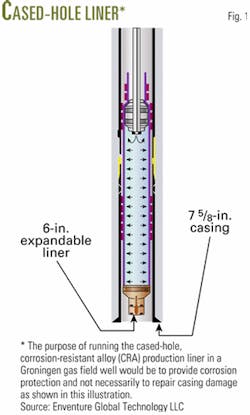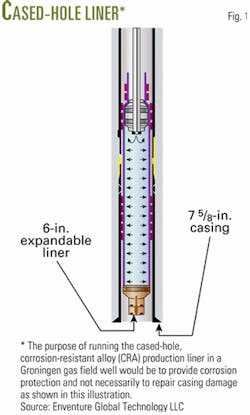CRA expandable tubulars create cased-hole production liner
Expandable-tubular technology advances as the industry extends its application from the drilling environment, where carbon-steel expandable tubulars reduce the telescopic effects of well construction, to corrosion-resistant alloy (CRA) production liners with gas tight connections.
Operator Nederlandse Aardolie Maatschappij (NAM), a 50-50 joint venture of Royal Dutch/Shell Group and ExxonMobil Corp., installed a 710 ft, 13% chromium (Cr13) CRA expandable liner in a test well in the Netherlands' Wanneperveen field.
In an announcement last month, Enventure Global Technology LLC said that the test well was the first CRA expandable-tubular installation of the company's Solid Expandable Tubular (SET) system and resulted from the cooperative effort between NAM, Shell International Exploration and Production BV, Enventure, and Vallourec & Mannesmann Tubes (VAM). NAM installed the liner to evaluate the technology in preparation for installing a much longer 5,500-ft liner in a well in the Netherlands' Groningen gas field, during a workover designed to increase the wellbore ID and the well's gas deliverability.
"This proof-of-concept test is in preparation for the installation of a 5,500-ft expandable CRA system to reline production casing so it can be used as the production conduit," said Lance Cook, president and CEO of Enventure.
He said, "The ability to expand Cr13 tubulars will allow far greater production deliverability from highly corrosive wells."
NAM's Groningen asset manager, Hans Bouman said, "This is one of the biggest step changes the oil and gas industry has undergone in 40 years."
He added that, "The increased durability of Cr13 tubulars in corrosive environments will dramatically reduce the limitations on how deep we can drill."
Liner deployment
Crews expanded the 6 in., 710-ft CRA liner in the Wanneperveen test well's 75/8-in., 39 lb/ft, 33.7 lb/ft, and 29.7-lb/ft casing, with elastomer seals in each section. Fig. 1 shows a hypothetical cased-hole liner installation. The Netherlands' application, however, would protect existing casing from internal corrosion and not necessarily repair casing damage, as the figure shows.
The combined mechanical and hydraulic forces averaged about 92,000 lb, to expand the 6 in., 18.6-lb/ft CRA pipe by 9.8% from the pre-expansion 5.39-in. ID to the post-expansion 5.92-in. ID. Engineers estimated the liner's post-expansion burst and collapse pressures at 7,000 psi and 4,000 psi, respectively. The natural conservation of material during the expansion process caused the liner length to shorten from 730 ft to 710 ft.
Groningen workover
In an interview with Oil & Gas Journal, Cook explained that NAM could use gas that it produces from the Groningen field as swing production or to meet gas demand during peak use periods.
Because of limitations in drilling additional wells in the field, the company must maximize the deliverability from existing wells to provide flexibility in meeting peak gas demand situations.
Rather than produce through the existing 51/2-in. tubing string that extends the well's entire depth, the well would produce, after the workover, through the CRA liner in the wellbore's lower section and through a shorter 7-in. tubing-string section in the top of the well.
Cook explained that NAM plans to reconfigure the well to allow installation of a 7-in. tubing string in the top of the wellbore to a depth of 2,000-3,000 ft, with the 5,500-ft CRA clad section below.
During the 5,500-ft liner expansion, 19 elastomer-seal sections, each with five 1-ft long elastomer-seal elements, will extrude between the well casing and expandable liner creating a seal and locking the liner in place.
The liner's top will overlap and seal into a polished-bore receptacle (PBR). The 7-in. tubing string, run into the well's top section, would seal with an overshot PBR configuration at the top of the CRA liner.
This configuration would give the wellbore an effective 5.92-in. diameter and increase its gas deliverability by as much as 60%, according to Cook.
Metallurgy
When asked about possible expansion ratios for CRA materials, compared to those of carbon steel, Cook indicated that cold working of the CRA liner could cause changes within the CRA affecting its corrosion resistance to the intended environment.
It is this concern that governs the maximum desired expansion ratio more than any limitations of the expansion process, he explained.
CRA materials can experience galling within the pipe and connections, requiring care in its use as expandable liners. The manufacture, deployment, and expansion process must ensure an adequate internal coating and lubrication between the expansion cone and liner.
For the carbon-steel expandable casing, eight sizes are available up to 133/8-in. For the CRA material, however, Enventure has manufactured only the 6-in. liner for use inside 75/8-in. casing.
Scaling expandable liners to larger sizes is a benign process or can be done more easily than scaling to smaller tubular sizes. Due to the high expense of CRA materials, the company would not stock an inventory of the liners but would build them by order, said Cook.
He added that the proof-of-concept installation in the Wanneperveen well and the planned liner in Groningen would open a large family of CRAs for expandable deployment, such as Inconel and Incoloy, which are third-party proprietary metallurgies.
Operators would determine the metallurgy required for the produced fluid environment.
Shell International Exploration and Production BV developed the material specifications for the Netherlands' CRA expandable liners, to ensure appropriate expansion and post expansion corrosion-resistance properties.
In addition, Shell Labs had evaluated the corrosion resistance, following cold-working expansion, of the chosen 13% chromium CRA.
Cook pointed out that, as wells become expensive and with challenging completions, such as in deep water, operators tend to err on the side of caution and run CRA materials for produced-fluid-exposed tubulars.
System integrity
Michael Payne, senior advisor for BP PLC, in a recent interview, referred to expandable tubulars as one of the most important technologies for the drilling industry (OGJ, June 17, 2002, p. 52).
He said that expandable tubulars are an important tool to alleviate casing-string limitations but qualified his statement by adding that the industry does not currently consider expandable tubulars for use as production casing.
The long-term integrity and reliability of the connections' seals are critical issues for production casing, said Payne.
Shell and VAM have teamed up on the problem, however, to develop proprietary gas tight, CRA-expandable connections and tubulars for CRA production-liner applications.
Cook explained that Shell would recover the CRA expandable liner from NAM's Wanneperveen well to test and qualify the connections' gas tight seal after expansion.
The companies are seeking verification of the testing with the European Drilling Engineering Forum, hoping to gain acceptance for qualifying the technology with industry, not only for this application but also for expandable tubulars in general, to avoid the need for operators to qualify it for every future application.
During other testing of expandable tubulars, Cook noted that couplings had the same strength as the theoretical pipe-body yield strength. When tested in tension and compression, failures to burst pressure may have occurred in the connection but at or above the theoretical pipe-body yield strength.
Cook said, "Even though we've done 76 jobs and over 63,000-ft of expanded pipe, the technology has not gained acceptance as mainstream. The industry is further along with this technology than many people realize."
Alternate technology
In a separate development, Houston-based Weatherford International Ltd. announced in July the first field deployment of an expandable casing-repair system, which the company calls MetalSkin, in a 7-in. water injection well in California.
About 250 ft of 51/2-in. carbon steel, solid-expandable tubing was deployed and expanded at a well depth of 5,300 ft, using it to shut-off several existing perforations that were no longer required.
Weatherford said a casing-caliper log that was run prior to the expandable-liner installation showed serious corrosion and significant casing wall-thickness loss and characterized the well's condition as creating a significant test for expandable-tubular technology.
Technicians expand the casing-repair liner with a Compliant Rotary Expansion System (CRES), which the company says can deploy the expandable cladding inside of casing despite serious corrosion and partial collapse.
In the California well, the company says the expansion system provided a strong seal and maximized the through-bore (ID) for future access to the lower exposed perforations.
Weatherford's product-line manager for the system, Gareth Innes, explained that the rotary compliant tool had three rollers in a plane and positioned 120° radially. Pressure-activated pistons force the rollers to expand the liner outward.
Innes highlighted that this expansion method can create metal-to-metal contact between the expandable liner and casing, avoids elastic relaxation, and allows the system to expand into irregular shapes such as oval or partial collapse. The company says the expandable casing-repair system incorporates specifically developed connections that it calls the Hydril DoubleFlex connection. "This technology is pervasive-it can be applied to all wells and all phases of a well's life," said Mark Hopmann, Weatherford Completion Systems president.
He added, "The successful field deployment of the MetalSkin system is one example of its potential to address numerous common well problems, such as corrosion [and] wear mitigation, perforation shut-off, and collapse-resistance enhancement."

